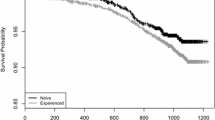Abstract
Statistical methods for survival analysis play a central role in the assessment of treatment effects in randomized clinical trials in cardiovascular disease, cancer, and many other fields. The most common approach to analysis involves fitting a Cox regression model including a treatment indicator, and basing inference on the large sample properties of the regression coefficient estimator. Despite the fact that treatment assignment is randomized, the hazard ratio is not a quantity which admits a causal interpretation in the case of unmodelled heterogeneity. This problem arises because the risk sets beyond the first event time are comprised of the subset of individuals who have not previously failed. The balance in the distribution of potential confounders between treatment arms is lost by this implicit conditioning, whether or not censoring is present. Thus while the Cox model may be used as a basis for valid tests of the null hypotheses of no treatment effect if robust variance estimates are used, modeling frameworks more compatible with causal reasoning may be preferrable in general for estimation.




Similar content being viewed by others
References
Aalen OO (1989) A linear regression model for the analysis of life times. Stat Med 8(8):907–925
Aalen OO, Borgan Ø, Gjessing HK (2008) Survival and event history analysis: a process point of view. Springer, New York
Aalen OO, Røysland K, Gran JM, Kouyos R, Lange T (2014) Can we believe the DAGs? A comment on the relationship between causal DAGs and mechanisms. Stat Methods Med Res. doi:10.1177/0962280213520436
Brown BM, Wang Y-G (2005) Standard errors and covariance matrices for smoothed rank estimators. Biometrika 92(1):149–158
Cheng SC, Wei LJ, Ying Z (1995) Analysis of transformation models with censored data. Biometrika 82(4):835–845
Cox DR (1972) Survival models and life tables (with discussion). J R Stat Soc 34:187–220
Cox DR, Oakes D (1984) Anal Surviv Data. Chapman & Hall/CRC, Boca Raton
Durham LK, Halloran ME, Longini IM, Manatunga AK (1999) Comparison of two smoothing methods for exploring waning vaccine effects. J R Stat Soc 48(3):395–407
Flanders WD, Klein M (2007) Properties of 2 counterfactual effect definitions of a point exposure. Epidemiology 18(4):453–460
Ford I, Norrie J, Ahmadi S (1995) Model inconsistency, illustrated by the Cox proportional hazards model. Stat Med 14(8):735–746
Gould A, Lawless JF (1988) Consistency and efficiency of regression coefficient estimates in location-scale models. Biometrika 75(3):535–540
Greenland S (1996) Absence of confounding does not correspond to collapsibility of the rate ratio or rate difference. Epidemiology 7(5):498–501
Hauck WW, Anderson S, Marcus SM (1998) Should we adjust for covariates in nonlinear regression analyses of randomized trials? Controlled Clin Trials 19(3):249–256
Hernán MA (2010) The hazards of hazard ratios. Epidemiology 21(1):13–15
Hernán MA, Robins JM (2015) Causal inference. Chapman & Hall/CRC, Boca Raton
Hernán MA, Hernández-Díaz S, Robins JM (2004) A structural approach to selection bias. Epidemiology 15(5):615–625
Kalbfleisch JD, Prentice RL (2002) The statistical analysis of failure time data, 2nd edn. Wiley, Hoboken
Kaplan EL, Meier P (1958) Nonparametric estimation from incomplete observation. J Am Stat Assoc 53(282):457–481
Lawless JF (2003) Statistical models and methods for lifetime data, 2nd edn. Wiley, Hoboken
Lin DY, Wei LJ (1989) The robust inference for the Cox proportional hazards model. J Am Stat Assoc 84(408):1074–1078
Lin H, Li Y, Jiang L, Li G (2014) A semiparametric linear transformation model to estimate causal effects for survival data. Can J Stat 42(1):18–35
Martinussen T, Vansteelandt S (2013) On collapsibility and confounding bias in Cox and Aalen regression models. Lifetime Data Anal 19(3):279–296
Pearl J (2009) Causality: models, reasoning, and inference, 2nd edn. Cambridge University Press, Cambridge
Robins J (1992) Estimation of the time-dependent accelerated failure time model in the presence of confounding factors. Biometrika 79(2):321–334
Strohmaier S, Røysland K, Hoff R, Borgan Ø, Pedersen T, Aalen OO (2014) Dynamic path analysis—a useful tool to investigate mediation processes in clinical survival trials. Submitted
Struthers CA, Kalbfleisch JD (1986) Misspecified proportional hazards models. Biometrika 74(2):363–369
Wei LJ (1992) The accelerated failure time model: a useful alternative to the Cox regression model in survival analysis. Stat Med 11(14–15):1871–1879
Yusuf S, Wittes J, Probstfield J, Tyroler HA (1991) Analysis and interpretation of treatment effects in subgroups of patients in randomized clinical trials. J Am Med Assoc 266(1):93–98
Author information
Authors and Affiliations
Corresponding author
Rights and permissions
About this article
Cite this article
Aalen, O.O., Cook, R.J. & Røysland, K. Does Cox analysis of a randomized survival study yield a causal treatment effect?. Lifetime Data Anal 21, 579–593 (2015). https://doi.org/10.1007/s10985-015-9335-y
Received:
Accepted:
Published:
Issue Date:
DOI: https://doi.org/10.1007/s10985-015-9335-y




